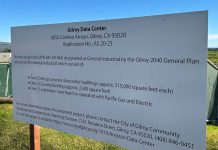Analysis claims project would bring in $60 million in
surplus
– but not for nearly 60 years
Morgan Hill – Coyote Valley will ultimately be a financial boon to San Jose, but those benefits are decades away and will be harder to achieve unless the city alters long-held plans for the largest undeveloped area remaining on the South Valley floor, according to a new fiscal analysis of the project.
In the analysis released Thursday, the Coyote Valley Specific Plan would generate anywhere from $57 to $68 million in annual surplus for San Jose, but those figures would not be reached until the project is complete, about 58 years after it is begun.
The project, which is expected to include 26,000 homes, more than 72,000 residents and 56,000 jobs, could cost the city millions annually for as long as two decades. Under the city’s general plan, the development is supposed to go forward only if it will not stress city finances and services, meaning it will require one or several additional assessment districts and the imposition of homeowner fees to cover the cost of providing public safety, parks and other neighborhood services.
“In the spirit of a Coyote Valley that is self-sustaining, we should be exploring some of these other financing options,” said San Jose planner Laurel Prevetti. “What we’re trying to identify is that there are techniques out there should the [San Jose City] Council choose to use them.”
The economic analysis was paid for by homebuilders and developers with substantial financial interests in Coyote Valley who have funded the nearly four-year Coyote Valley planning process. It examines five scenarios that balance the need to attract new jobs to the area with developers’ desire to build new homes.
The city’s general plan now demands that no home be built until 5,000 jobs are located in Coyote Valley. According to the analysis, that scenario would be one of the quickest to put the project in the black, but it would delay the start of the project as there is no signs that that many jobs are imminent in Coyote Valley.
All the scenarios ultimately result in solvency, but the two projected to be most successful are those that allow for houses to be built immediately. One scenario, as proposed last year by San Jose Mayor Ron Gonzales, would allow one house for every two new jobs, another would allow for a market-based buildout with limited job requirements.
The financial investment needed to develop Coyote Valley is daunting. To build houses there, developers will need to invest at least $1.5 billion in infrastructure and capital improvements, and ongoing services will cost in the tens of millions annually.
Those figures could make it hard for all but the wealthiest citizens to afford to live in Coyote Valley. The city is trying to find a way to price 20 percent of the housing, rental units mostly, at levels considered “affordable,” but there will likely be thousands of homes priced at near or more than $1 million. The cheapest single family homes will hit the market near $800,000, and homeowners may be tagged with a basket of assessment and homeowners’ fees in addition to their mortgages. The true cost of joining what could be one of the best neighborhoods in California is still unknown.
“That’s why the affordability requirement is so critical,” Prevetti said. “We really do want a mixed-income community. We don’t want it to be just for the very wealthy.”
The fiscal analysis will be subjected to extensive review by the Coyote Valley Specific Plan Task Force and the San Jose City Council. First up is the task force, which will examine the financial assumptions underlying the study at its next meeting.
“The assumptions are key,” Prevetti said. “We are not ready to discuss or ask the task force to pick a preferred alternative. It’s going to take us a bit longer to get there.”
Why you should care
Planning for Coyote Valley is reaching a level of
detail that could mean development just north
of Morgan Hill in the near future. The Coyote Valley Specific Plan Task Force and the San Jose City Council could make
decisions in the next
several months to clear the way for homes there.
To read the report, go to www.sanjoseca. gov/coyotevalley/fiscal%20Report/Draft_Fiscal_Report.pdf













